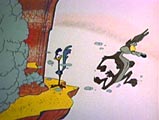I want to highly recommend Josh Marshall’s excellent article printed in the New Yorker. It’s a very sophisticated look at the issue of how the United States has managed it’s emerging power on the planet.
I found particularly facinating by one story he tells.
Josh’s story expands on one of the classic cartoons that people use to sketch how communties are kept coherent; e.g. “nothing brings people together like a common enemy.” I don’t like the quality of exagerated speach in that aphorism, but I entirely agree with it’s general form that common cause is at the heart of any community. There are many species of common cause: a body of practice, a proffession, shared turf, a public good, a shared goal, a shared experiance, contracts and other kinds of ties, etc. etc. Fear of a common enemy is just one; probably a rare one.
Josh looks at what happens when our common enemy disappears from the landscape. In a community is organized around a common enemy members will subordinate their own goals and desires. They will follow leaders. They desire the coordination efficencies of a command hierarchy. They do this not out of respect for the leader but out of fear of the enemy. It is rarely as stark as that. All the baggage get’s thrown on the cart. Everybody will decorate their justifications for riding on the bandwagon. They drag out the usual suspects: shared values, a common narrative, tradition, social ties, etc. etc.
So when the common enemy disappears it’s interesting to look at what happens. One thing happens to the members and another happens to the leaders.
Regular members first. People start dropping off the bandwagon. They start following their own muse. This alone is enough to change the topology of the community. It grows less intense, more difuse. The resources that people put into it fall. The strength of the ties grows a bit weaker. A general sense of nostalgia emerges for the good old days. But nostalgia isn’t a force sufficent to create or maintain a community.
The second thing that happens is more interesting. The heart of Josh’s point is what happens to those who are at the top of that command hierarchy.
In the presence of a common foe the leaders need only to speak softly and the subordinate members listen respectfully and attempt to execute. After the common foe departs the leaders are a little like the cartoon character who’s run off the cliff but has yet to look down.

So what becomes of the leaders? One possiblity is that they pack up and go home; or at least step back from the podium; or they stop speaking softly and try turning up the volume. For many leaders their idenity is deeply entangled in the community, so walking off isn’t easy.
So Josh tells two stories that fit this pattern. In the modern story on the common enemy was the Soviet Union, the leader was America, and the rest of the industrialized world the subordinate community members. In the historical story the enemy was France, the leader was England, and the community members were England’s colonies.
In that story once England triumphed over France (we called that French and Indian war) the leader announced from the podium that the colonies should help pay the bill for the war. We proceeded to: throw tea in the harbor, hop off the bandwagon, and go our own way.
I find the ‘pay for the war’ part of that story quite enlightening. It draws our attention to a third player in the story. So far we only noticed the leaders and the subordinate community members. What ‘pay for the war’ reveals is the institutional infrastructure found in any significant community. The bandwagon’s physical manifestation. As the intensity of the community declines the resources available to fund the maintainance of the bandwagon decline.
The leader is left holding the bag. That, it seems to me, increase the chance that he will deal with the situation by raising his voice. He doesn’t really have the option of stepping away from the podium, or at least not until such time as he’s found a way to scale back the bandwagon. It’s facinating how a democracy deals with a situation like this. With lucky your community members elect different leaders. Ones who lack the same affection for the good old bandwagon. Corporate boards play a similar function, again if your lucky.




 This
This